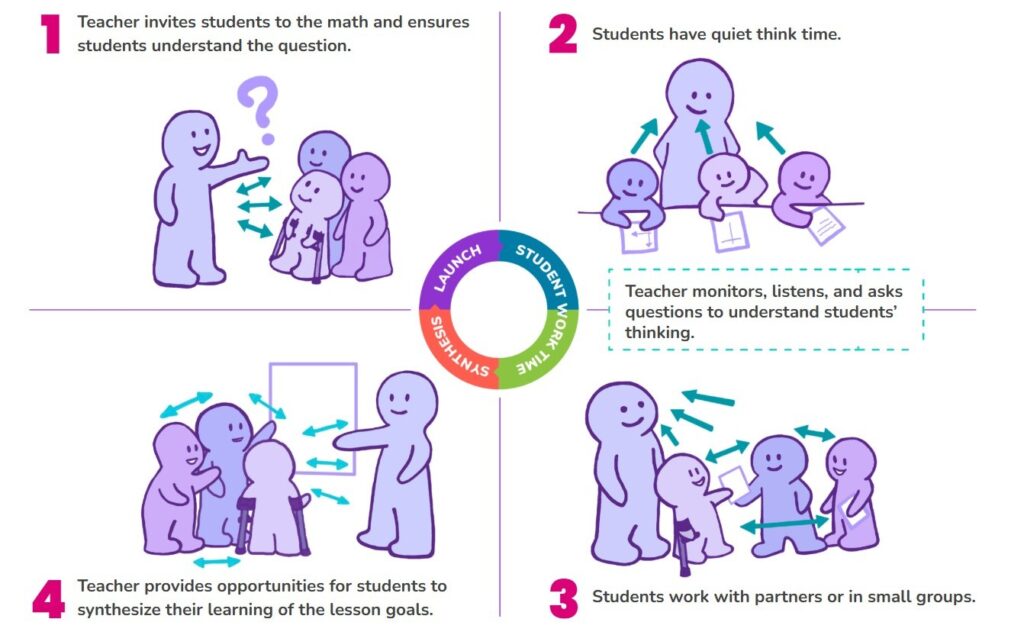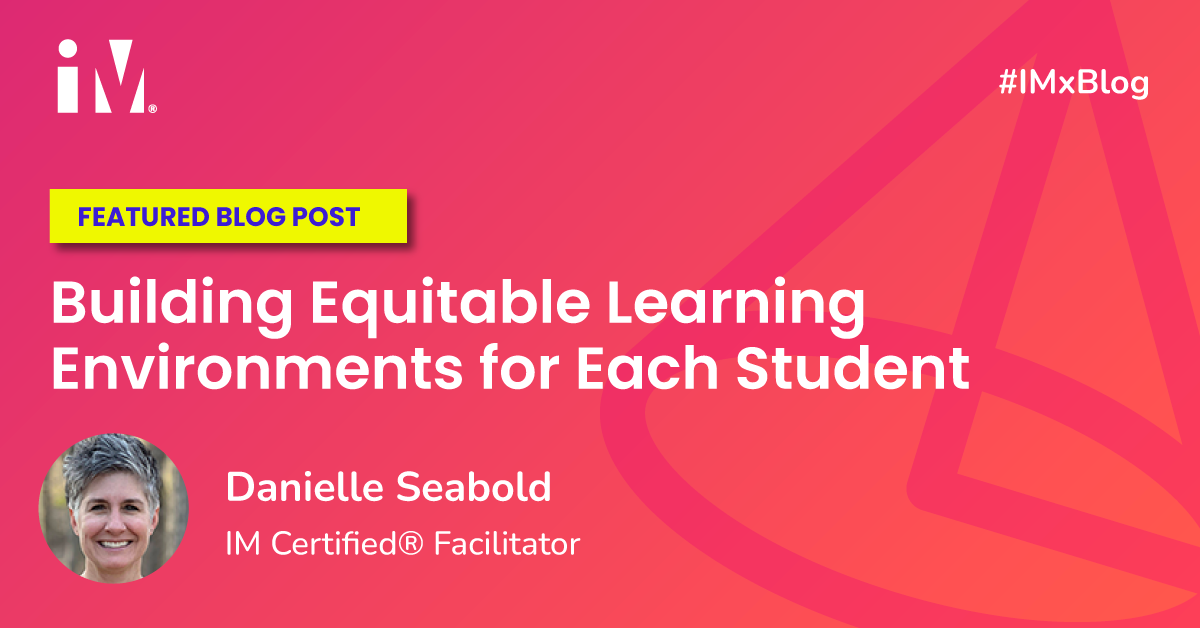By Danielle Seabold, IM Certified® Facilitator
“All students can be successful in mathematics.”
For most mathematics educators, we lean into this. We believe that all students can learn mathematics, and that they can be successful. However, as we focus our lens on the word all, what do we see?
Picture your school or district. What is the lived experience of your students? Which student groups are:
- excluded from advanced course enrollment or gifted and talented programs? Which are included?
- impacted by chronic absenteeism? Which benefit from daily instruction?
- over-represented in disciplinary and behavioral data? Which are under-represented?
- over-represented in special education programs? Which are under-represented?
- thriving with “how we do things” in our mathematics program? Which are working hard just to survive?
What patterns do you notice?
The way school systems are built create disparities for students who have been racialized and marginalized—including students of color, those affected by poverty, LGBTQIA+ students, those who are physically or cognitively diverse, and more. If your picture reveals that your students are not thriving within their mathematics learning environment, you’re not alone.
As educators committed to acting on our belief that all students can learn mathematics, we must ask ourselves: Who owns this? What does our data tell us? At the most basic level, the data tells us that our school system works as it was originally intended—for some—and continues patterns of marginalization and oppression for others. It tells us that our core belief might be in need of a reboot.
All students can be successful in mathematics within an equitable educational system. Now, we have something to act on. Because it’s not our students who need “fixing,” but our system. We’re called to uncover and counter our own unconscious biases and rebuild a system that is equitable, recognizing the brilliance of each of our students.
In 2018, TNTP released “The Opportunity Myth,” which highlights four key resources that influence a student’s school experience and outcomes.
Resource 1: Consistent opportunities to work on grade-level content
Resource 2: Strong instruction where students do most of the thinking
Resource 3: Deep engagement in what they’re learning
Resource 4: Teachers who hold high expectations for students and believe they can meet grade-level standards
We know that “students achieve much more with even a modest increase in one resource. Imagine what’s possible with consistent access to all four.” (TNTP, The Opportunity Myth)
Teachers and students who are partnering in classrooms across the United States to teach and learn with IM® Math curricula are reaping the benefits of consistent access to all four resources.
Resource 1
Consistent opportunities to work on grade-level content
IM Math curricula are problem-based and built from the Common Core State Standards for Mathematics. The curricula set students and teachers up to learn math for life by providing grade-level, standards-built learning activities within each lesson. Activities and tasks contain multiple entry points and support students using different approaches.
All students in the class engage in these tasks, so students have access to grade-level mathematics daily. Not only that, the mathematical journey they take across the school year is a coherent progression of mathematical learning within and across grade levels. Embedded instructional routines and support for learning provide students with another level of access to deep mathematical learning across the school year.
Resource 2
Strong instruction where students do most of the thinking
Each IM Math lesson invites students into the mathematics through active collaboration with their teacher and peers. Together, they explore concepts and procedures, experiment with representations and strategies, and build understanding through discussion. Students then consolidate their learning by connecting their ideas to the lesson’s goals. Finally, they apply what they’ve learned in the daily Cool-down.
Resource 3
Deep engagement in what they’re learning
IM classrooms are problem-based classrooms where students spend the majority of the time doing math. Teachers facilitate students’ learning by launching activities in ways that ensure students understand what that task is asking of them. Students are given individual think time to consider the math, generate their own ideas, represent them, and begin to solve the problem. Next, students partner in small groups to share their thinking, representations, and solution strategies.
Because learning is social, students benefit from working alongside their classmates as they hone their thinking, representations, and strategies. All the while, the teacher circulates (in-person or virtually) to monitor student progress, ask probing questions, and collect student thinking. Lastly, the whole class comes together to synthesize learning, using what their teacher has collected from them, to reach the explicit learning goals of the lesson.
IM’s Model for Problem-Based Instruction

Resource 4
Teachers who hold high expectations for students and believe they can meet grade-level standards
IM Math teachers witness their students doing the math, thinking critically, and engaging deeply with it. They see their students knowing, using, and enjoying mathematics—sometimes in ways that surprise even the students themselves. These daily moments reinforce what we believe at our core: All students are capable of brilliance. And that belief is evidenced in the high expectations we set for them, the support we provide, and the confidence we help students build in themselves.
Conclusion:
Let’s further invest in and commit to enhancing these four key resources so that our students are met with equitable learning environments every day, in every way. Let’s flip the script on some of our data and on the lived experiences of some of our students, especially our students who are racialized and marginalized, so that all students are successful in mathematics.
Next Steps:
Gather your data. Dive into it and explore the questions posed at the beginning of this post. Ask yourself:
- Which of our students have consistent opportunities to work on grade-level content? Which do not?
- Which of our students get to “do math” every day? Which do not?
- Which of our students get to know, use, and enjoy mathematics? Which do not?
- Which of our students get to partner with teachers who hold high expectations of them and know they can do it? Which do not?
Then, plan. Ask yourself:
- Why? What’s getting in the way for those who do not? Do we need to remove a barrier or add a support?
- How does our mathematics program need to change?
- What support do educators need in removing the barriers that are producing this inequity?
- What support can educators provide our students to mitigate the inequity?
- Which components of the IM Math curricula can we enhance so as to provide our students with greater access to the four key resources?
Then, act.
For more on building equitable learning environments, check out these additional posts on the IM Certified blog:
Inviting Students to the Math Party: Creating an Inclusive and Engaging Math Community by Cherelle McKnight
5 Steps We Must Take to Truly Create An Inclusive Representative, and Equitable Society by Odalis Amparo
Making Math Relevant Starts with Valuing Your Students’ Experiences by Anita Crowder
 Danielle Seabold
Danielle Seabold
IM Certified® Facilitator
Danielle S. began her career teaching high school math and physics in Kalamazoo, MI. She had the privilege of consulting with the Charles A. Dana Center in Austin, TX, where she co-authored the Academic Youth Development program, seeking to transform mathematics education for students. Later, she returned to Michigan as a regional mathematics consultant and coach. She is committed to recognizing and removing inequities in students’ formal educational experiences to help realize the power of mathematics for all students.
